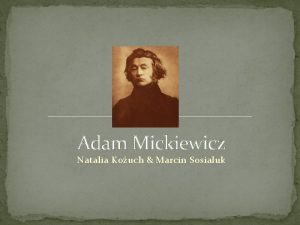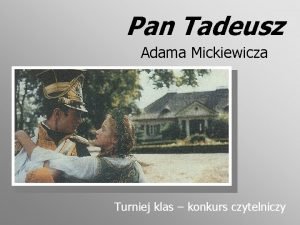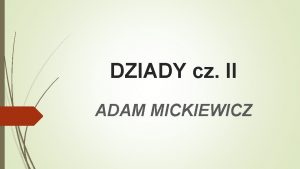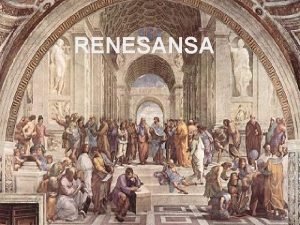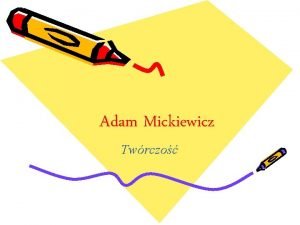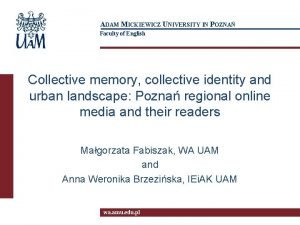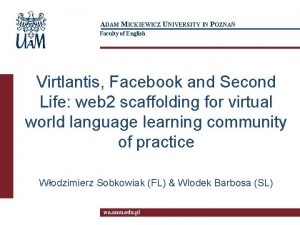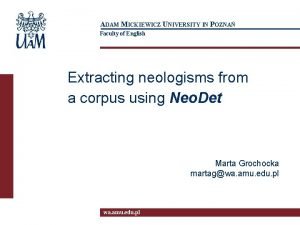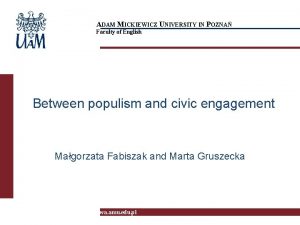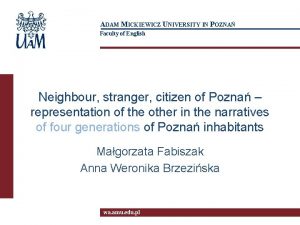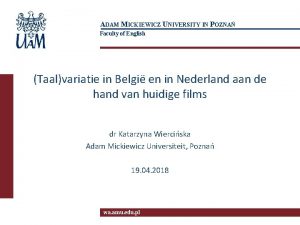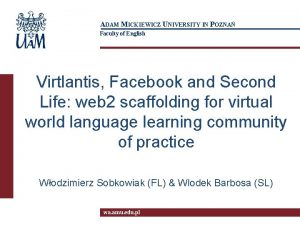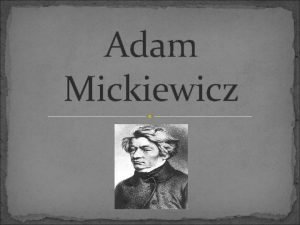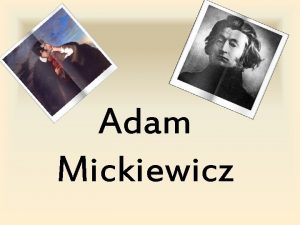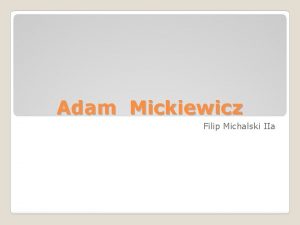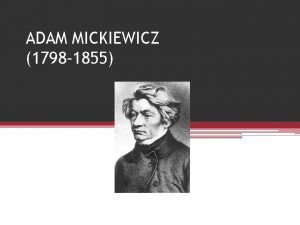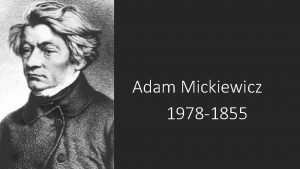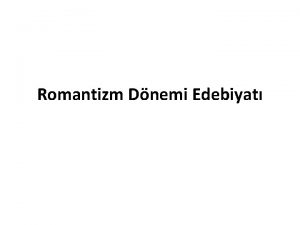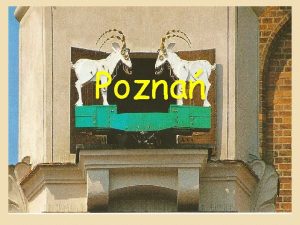ADAM MICKIEWICZ UNIVERSITY IN POZNA Faculty of English































![Transcription conventions (Jefferson 2004) • • • • [] = // Overlapping speech ‘Latching’ Transcription conventions (Jefferson 2004) • • • • [] = // Overlapping speech ‘Latching’](https://slidetodoc.com/presentation_image_h2/df0d7e79c41bf263721040a5e6ab9d57/image-32.jpg)
- Slides: 32

ADAM MICKIEWICZ UNIVERSITY IN POZNAŃ Faculty of English Discourse Analysis (DA) as an underappreciated approach in autism research Eliza Maciejewska Faculty of English, Adam Mickiewicz University in Poznań emaciejewska@wa. amu. edu. pl

Outline THEORETICAL BACKGROUND • Approaches to autism research • Qualitative methods: Discourse Analysis PROJECT • Description of the project • Data analysis - Picture description - Interview • Conclusions

Approaches to language and communication in autism research • Individual-focused work (O’Reilly et al. 2016) • Experimental paradigm (Colle et al. 2007) • Quantitative vs qualitative approach

Autism is one word attempting to describe millions of different stories Stuart Duncan 4

Qualitative methods in autism research ”Employing qualitative methods for the study of ASD is an important way of giving a ‘voice’ to participants and can be particularly useful for empowering vulnerable or disadvantaged people groups. ” (O’Reilly et al. 2016) ”Qualitative methods are able to go beyond what works to show and why a particular practice may be effective. ” (O’Reilly et al. 2016)

Language in Discourse Analysis ”(…) discourse analytic approaches treat language use as an interactional accomplishment, as social action, and also as an experience in and of itself. This theorization of language and methodological approach offers a corrective to the dominant and largely tacitly held view that language, in its essence, is a referential system and a reflection of an individual’s cognition. ” (Sterponi & de Kirby 2016)

Discourse Analysis • Discourse Analysis is an umbrella term which encompasses different approaches: discourse analysis proper, interactional linguistics, and conversation analysis (Sterponi and de Kirby 2016; Roberts and Sarangi 2005) • Discourse analysis (DA) is an approach to the study of language whose aim is to identify and describe regular patterns in the use of language (Herring 2004) • DA assumes that interlocutors co-construct any communicative event (Schiffrin et al. 2001)

Conversation Analysis (CA) ”CA is a qualitative approach that focuses on the study of interaction. The core aim of this approach is to examine the social organisation of activities that are produced in interaction, through talk. ” (O’Reilly et al. 2016) ”(…) turns in conversation are interlocked; a current action projects a next relevant action and often responds to a prior action. ” (Sterponi & de Kirby 2016)

DA vs CA ”DA builds a wider analytic frame than does CA to understand interactional sequences by reaching beyond the ‘here and now’ of social interactions to enrich a sense of their context and to examine the circumstances and the sentiments that inform them. ” (Solomon et al. 2016) 9

Stages of DA (Sarangi 2013) • 1 • 2 • 3 • Collecting the data (audio or video recordings) • Transcribing the data (using transcription conventions) • Analysing the data 10

PROJECT

Aims of this presentation Show DA can help illuminate: 1. the communicative practices of individuals with autism 2. the ways in which these practices are influenced by the neurotypical interlocutor

Data • Participants - 3 adolescents diagnosed with autism (2 girls, 1 boy) - Age: 17 -18 years old - Language: Polish • Data - transcribed audio recordings of two tasks: - Picture description - Interview

DATA ANALYSIS

TASK 1: PICTURE DESCRIPTION ”What is happening in the picture? ”

Source: Vandewiele, A. (2005).

Listing - verbs 1 E: co się dzieje na tym obrazku? what is happening in the picture? 2 P 1: (na tym) ludzie są na plaży i (3. 0) robią babki z piasku (1. 0) rozmawiają (2. 0) siedzą (5. 0) kopią, jeden trzyma koło ratunkowe (6. 0) (in the) people are on the beach and (3. 0) are making sand cakes (1. 0) [they are] talking (2. 0) sitting (5. 0) digging, one is holding a life ring (6. 0)

Using ”templates” 1 P 2: ((odchrząknięcie)) tutaj (. ) dzieci (. ) y tutaj dzieci i dorośli bawią się na 2 3 4 5 6 7 plaży. (3. 0) […] ((clearing her throat)) here (. ) children (. ) erm here children and adults are playing on the beach. (3. 0) […] E: mhm↑ P 2: (7. 0) E: coś jeszcze mi możesz opowiedzieć na tym obrazku? (. ) co się dzieje? is there anything else you can tell me about this picture? (. ) what is happening? P 2: tutaj dzieci: robią zamki z piasku. here childre: n are making sand castles E: ˚zamki z piasku˚. okej, co dalej? ˚sand castles˚. OK, what else? P 2: tutaj dorośli się opalają i odpoczywają. (17. 0) here adults are sunbathing and resting. (17. 0)

Repetitions 1 E: jak myślisz, dobrze się tam bawią? what do you think, are they having fun there? 2 P 2: dobrze się bawią. (11. 0) they are having fun. (11. 0) 3 E: i co, coś jeszcze byś chciała dodać czy to już koniec? so, would you like to add anything or is that all? 4 P 2: >nie, niekoniecznie. nic nie chcę dodawać. < >no, not necessarily. I don’t want to add anything. <

TASK 2: INTERVIEW

Q&A exchange - yes/no answers 1 2 3 4 5 6 7 8 E: (…) jak dzisiaj było w szkole? (…) how was it at school today? P 1: dobrze. fine. E: a coś więcej mi powiesz? will you tell me something more? P 1: nie. no. E: a słyszałam że: (3. 0) że chodzisz na kółko (. ) filmowe, tak? (…) and I’ve heard tha: t (3. 0) you are attending a film (. ) club, right? (. . . ) P 1: tak. yes. E: i jak tam jest? and how is it there? P 1: fajnie. nice. 21

Topic management (shifting) 1 E: mhm. (. ) ale tych prób dużo pewnie musi być, [żeby tak grać? = mhm. (. ) well there has to be a lot of these rehearsals [to play like this? = 2 P 3: [ta: k =tak. [ye: s =yes. 3 E: (2. 0) i- i jak wygląda taka próba? możesz mi opowiedzieć o niej? (2. 0) an- and what does such a rehearsal look like? can you tell me about it? 4 P 3: no: jest- (4. 0) próba, że spotyka się kilka osób i potem (. ) nieraz (. ) w zeszłym roku też byliśmy na targach poznańskich: well, there is- (4. 0) a rehearsal, so a couple of people meet and then (. ) sometimes (. ) last year we went to the trade fair in Poznan 5 E: mhm (3. 0) 6 P 3: edukacyjnych znaczy się, przepraszam y: : które były- na któ: - gdzie też graliśmy jakieś przedstawienie. education (fair) I mean I’m sorry erm: : which was- at whi: - where we also played [sic!] some theatre performance

CONCLUSIONS

Conclusions • • Communicative practices Interlocutor’s contribution Different tasks, different performance Practical implications

DA vs experimental paradigm ”(…) prototypical features of autistic language appear not solely as expressing an underlying neurological condition, but as responses to contextual circumstances and as efforts of the child at finding his way in interaction. ” (Sterponi and de Kirby 2016) 25

DA vs individual-focused approach ”Our analysis of the exchanges broadens the perspective on these phenomena beyond deficit interpretations and discerns resources, abilities and interactional processes previously unrecognized. ” (Sterponi and de Kirby 2016) 26

Practical implications (…) these approaches can and do augment existing knowledge of ASD in a way that has practical and theoretical value for the field. ” (O’Reilly et al. 2016) ”(…) discourse analytic findings can potentially provide a sound platform to base assessment of professional practice, with the possibility of raising awareness, planning training activities and fostering change in communicative practices. ” (Sarangi 2013)

Practical implications ” If we regard stereotypical features of autistic language as manifesting deficits alone, we are likely to make attempts to encourage the child to suppress or replace them. (…) Consider what would follow, by contrast, from an appreciation that these linguistic features often manifest important sensitivities and competencies (…) From such a vantage, we may conceive of interventions with the aim of building on and scaffolding these developing abilities. ” (Sterponi and de Kirby 2016)

Thank you! 29

Selected references • • Colle, L. et al. (2007) ”Narrative Discourse in Adults with High-Functioning Autism or Asperger Syndrome”. Journal of Autism and Developmental Disorders 38: 28 -40 Herring, Susan. C. 2004. Computer-mediated discourse analysis: An approach to researching online behavior. In Designing for virtual communities in the service learning, eds. Sasha A. Barab, Rob Kling and James S. Gray, 338 -376. New York: Cambridge University Press. Jefferson. G. 2004. Glossary of transcript symbols with an introduction. In G. H. Lerner (ed. ) Conversation Analysis: Studies From the First Generation, 13 -23. Philadelphia, PA: John Benjamins. O’Reilly, M. , Lester, J. Muskett, T. (2016) Discourse/Conversation Analysis and Autism Spectrum Disorder. Journal of Autism and Developmental Disorders 46, 355 -359. Roberts, C. and Sarangi , S. (2005) ” Theme-oriented discourse analysis of medical encounters. ” Medical Education. 39, 632 -640. Sarangi , S. (2013). Practising Discourse Analysis in Healthcare Settings. In The SAGE Handbook of Qualitative Methods in Health Research eds. I. Bourgeault, R. Dingwall and R. de Vries. London: SAGE Publications Ltd. Schiffrin, D. et al. (eds. ). 2001. The handbook of discourse analysis. Malden, MA: Blackwell. Solomon, O. (2004). Narrative introductions: discourse competence of children with autistic spectrum disorders. Discourse studies. 6(2): 253 -276.

Selected references • • Solomon, O. , Heritage, J. , Yin, L. , Maynard, D. W. , Bauman, M. L. (2016). ‘What Brings Him Here Today? ’: Medical Problem Presentation Involving Children with Autism Spectrum Disorders and Typically Developing Children. Journal of Autism and Developmental Disorders 46, 378 -393 Sterponi, L. and K. de Kirby (2016) ”A Multidimensional Reappraisal of Language in Autism: Insights from a Discourse Analytic Study”. Journal of Autism and Developmental Disorders 46: 394 -405 Tager-Flusberg, H. (1999). The challenge of studying language development in children with autism (http: //www. abiliko. co. il/Media/Uploads/challenge_lang_dev_autism. pdf) (access: 05. 06. 2017). Tager-Flusberg, H. (2004). Strategies for Conducting Research on Language in Autism [electronic version]. Journal of Autism and Developmental Disorders, 34, 75 -80. , Vandewiele, A. (2005) Moje ciało. Warszawa: Wydawnictwo REA Wiklund, M. (2016). ”Interactional challenges in conversations with autistic preadolescents: The role of prosody and non-verbal communcation in other-initiated repairs” Journal of Pragmatics 94: 76 -97. http: //www 2. le. ac. uk/departments/psychology/research/child-mental-health/cara 1/faqs/differences http: //www. xavier. edu/library/students/documents/qualitative_quantitative. pdf
![Transcription conventions Jefferson 2004 Overlapping speech Latching Transcription conventions (Jefferson 2004) • • • • [] = // Overlapping speech ‘Latching’](https://slidetodoc.com/presentation_image_h2/df0d7e79c41bf263721040a5e6ab9d57/image-32.jpg)
Transcription conventions (Jefferson 2004) • • • • [] = // Overlapping speech ‘Latching’ stretch of talk, i. e. , no discernible gap between the utterances An interruption, i. e. a point in the interaction where another interlocutor takes over the conversational floor before the current speaker has finished his/her utterance. (1. 0) pause length (in seconds) (. ) A ‘micropause’, i. e. , a pause of less than a second (( )) A nonverbal activity, e. g. , crying () The occurrence of an unclear utterance; or a removal of a part of the utterance due to privacy policy. ba: d Prolongation of immediately preceding sound. The more colons the greater the extent of the stretching. ? Rising intonation. Falling intonation °bad° Lower volume than surrounding talk <bad> Slower than surrounding talk >bad< Faster than surrounding talk Bad Stressed syllable BAD Higher volume 32
 Adam mickiewicz biography
Adam mickiewicz biography Czyje portrety zdobiły ściany soplicowskiego dworu
Czyje portrety zdobiły ściany soplicowskiego dworu Dziady cz 2 prezentacja
Dziady cz 2 prezentacja Predstavnici renesanse
Predstavnici renesanse Dyfuzja tożsamości
Dyfuzja tożsamości Renesanse
Renesanse Mickiewicz urodzony
Mickiewicz urodzony Herb poraj mickiewicz
Herb poraj mickiewicz Herb poraj mickiewicz
Herb poraj mickiewicz Portret adama mickiewicza
Portret adama mickiewicza Adam white facebook
Adam white facebook Herszon kherson maritime college of merchant marine fleet
Herszon kherson maritime college of merchant marine fleet University of bridgeport computer science
University of bridgeport computer science Computer science tutor bridgeport
Computer science tutor bridgeport Hubert kairuki memorial university faculty of medicine
Hubert kairuki memorial university faculty of medicine Solid thyroid nodule
Solid thyroid nodule Applied medical sciences
Applied medical sciences Fsu cs faculty
Fsu cs faculty Mendel university - faculty of business and economics
Mendel university - faculty of business and economics Singularity university faculty
Singularity university faculty Agnes csaki semmelweis
Agnes csaki semmelweis Masaryk university medical faculty
Masaryk university medical faculty Faculty of engineering university of porto
Faculty of engineering university of porto Webkredit cuni
Webkredit cuni Faculty of veterinary medicine cairo university logo
Faculty of veterinary medicine cairo university logo Faculty of law of the university of zagreb
Faculty of law of the university of zagreb University of montenegro faculty of law
University of montenegro faculty of law University of kragujevac faculty of technical sciences
University of kragujevac faculty of technical sciences University of cologne faculty of management
University of cologne faculty of management Leading university sylhet tuition fees
Leading university sylhet tuition fees Hacettepe university faculty of medicine
Hacettepe university faculty of medicine Brown university computer science faculty
Brown university computer science faculty Dosrsal
Dosrsal
